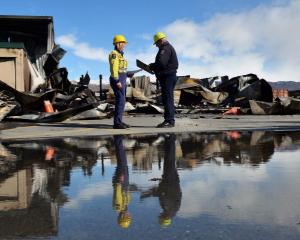Eighteen trampers were evacuated by helicopter from the remote Siberia Valley, near Makarora, after the unoccupied 20-bunk hut burnt to the ground on Wednesday afternoon.
Central Otago Lakes fire safety officer Stu Ide said a preliminary site inspection indicated a gas-powered fridge located in the hut warden's quarters of the Department of Conservation building was probably the source of the fire.
"It was the primary area of concern. The first flames in the building were noticed above the fridge," he said.
A volunteer hut warden was the first person to arrive at the burning hut and initially tried to access a fire extinguisher in the warden's quarters before smoke and flames forced a retreat.
Some trampers' belonging were salvaged from the bunk quarters before the fire spread, but everything else was destroyed in the blaze, Mr Ide said.
Given the hut was unoccupied at the time, there was no way to control the fire once it took hold, he said.
Doc Wanaka area manager Paul Hellebrekers estimated the insured hut would cost more than $250,000 to replace.
Mr Ide said his investigation was ongoing, with maintenance checks about when regular servicing had taken place on the lpg-fired fridge, the next step in the process.
In his experience, he had never come across a fire which had started in a tramping hut from a gas-powered fridge, although the device has been identified as a fire hazard in caravans, he said.
"There is a flame involved for burning off the lpg so there is a potential for fire," Mr Ide said.
The fridge was connected by copper piping to 45kg gas cylinders located on the exterior of the wooden structure, he said.
There was little that could have been done to save the building, given its remote location and "virtually nil" access to water for firefighting purposes, he said.
"If you don't get control of a fire within the first two or three minutes they are pretty much impossible to contain," Mr Ide said.




